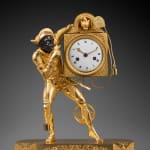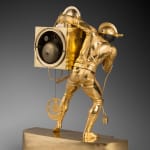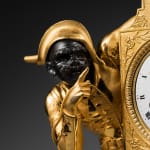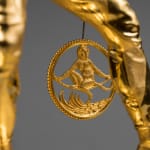Pierre-Philippe Thomire (attributed to) French, 1731-1843
Further images
Literature
Tardy, "French Clocks - The World Over", 1981, vol. I, pl. LXXXIII, back cover, full page colour, illustrating an almost identical clock. Alvar González-Palacios, "Il Patrimonio artistico del Quirinale, Gli arredi Francesi", 1996, p. 309, pl. 90, illustrating a similar clock but with a different base, in the Quirinal Palace in Rome. Giampiero Negretti and Paolo DeVecchi "Faszination Uhr", 1996, front cover illustrating a clock of the same model. Elke Niehüser, "Die Französische Bronzeuhr", 1997, p. 168, pl. 270, illustrating a similar clock with silvered dial and ribbon-tied palm fronds on the base. And p. 230, pl. 657, illustrating another clock case of very similar form to the present model. "Musée François-Duesberg, Arts Décoratifs 1775-1825", 2004, p. 48, illustrating a comparable clock in the Musée François-Duesberg.
A rare and extremely fine quality late Empire gilt and patinated bronze Harlequin mantel clock of eight day duration housed in a superb case attributed to Pierre-Philippe Thomire. The white enamel dial with Roman and Arabic numerals and a fine pair of gilt brass hands for the hours and minutes. The movement with anchor escapement, silk thread suspension, striking on the hour and half hour, with outside count wheel and a free swinging pendulum centred by a cut-out monkey. The square case modelled as an arched top wall clock complete with simulated weights and chains, the dial and foliate bezel decorated in each corner with floral and foliate spandrels, surmounted by a cockerel who appears from behind an opened door on which is engraved: 'Le Point du Jour', the square clock case supported by the nimble figure of Harlequin who wraps his left hand behind the clock while balancing one corner on his hip, Harlequin dressed in typical costume with a chequered patchwork vest and pantaloons, a baton at his waist and a cloche hat above his carnival mask, bushy eyebrows and thick moustache, balancing his weight on his right leg he points his finger to the clock dial while standing on a rectangular base mounted on the frieze by anthemion and foliate decorations and flanked by a pair of butterflies at either end, the whole on flattened bun feet
Paris, date circa 1815-20
Height 37 cm; width 24 cm; depth 11 cm.
The design for this ingenious clock case featuring the figure of Harlequin was inspired by the characters of the Commedia dell'arte and became extremely popular during the late Empire period and the early years of the Bourbon Restoration. Among a limited number of other known examples is one from Baron François Duesberg's collection, housed in the Musée Duesberg at Mons in Belgium as well as another from the collection of the late Hon. Mrs. Bootle-Wilbraham, which was sold at Christie's London on 19th March 1992 lot 38. Since both the latter cases were by the renowned firm of Parisian bronziers Thomire et Cie and housed movements by Louis Moinet, it can be assumed that the present clock is also by Pierre-Philippe Thomire (1751-1843) and Louis Moinet (1768-1853).
In addition to those examples are a number of similar clocks from equally prestigious collections, notably one formerly in the collection of Charles-Ludovic de Bourbon which today is displayed in the Palazzo Riccardi in Florence as well as another in the Quirinal Palace in Rome. Added to them were two other versions from the collection of Mrs. Robert Tritton of Godmersham Park in Kent which were sold at Christie's 6-9th June 1983, lots 101 and 347 as well as another formerly in the collection of Mrs. Charles Munn, which was sold by Christie's, New York, on 1st November 1989, lot 155.
While a number of clock cases of the period were inspired by classical antiquity, the present clock case model was inspired by the Commedia dell'arte. Harlequin, who was a central and very popular character played the part of a jovial rascal who worked a valet and as he was poor he wore patched clothes, hence the chequered material that characterises his costume. As here he also always wore a mask, a round shaped hat and was occasionally accompanied by a monkey, as shown in Meissen porcelain figurines of Harlequin and, as here, so ingeniously within the pendulum.
Harlequin points to the clock itself which is loosely modelled on a German Black Forest cuckoo clock. But here instead of the cuckoo emerging from behind a door is a cockerel, a bird which is so often associated with the dawn and appears in paintings as well as clocks as a symbol of the new day. That theme is reinforced by the wording on the inside of the door which reads "Le point du Jour", meaning the day break or dawn. Interestingly other similar clock models have the words 'L'artiste du Jour'. The theme of dawn or the new day is again cleverly repeated on the clock's base which features at either end butterflies; these refer to the Horae (the mythological attendants of Aurora who represented the dawn), who were often portrayed in art as having butterfly wings.
As noted the case, which is of the finest quality, is attributed to the renowned bronzier Pierre-Philippe Thomire. Born into a family of ciseleurs, Thomire began working with the renowned bronzier Pierre Gouthière as well as Jean-Louis Prieur ciseleur-doreur du roi, before opening up his own workshop in 1776. Famed for his production of finely chased gilt bronze objets de luxe, of which a large quantity were commissioned by the royal household, Thomire frequently collaborated with the marchand-merciers, such as Simon-Philippe Poirier and his successor Dominique Daguerre. In addition, Thomire supplied finely chased mounts to leading ébénistes of his day such as Guillaume Benneman and Adam Weisweiler. Thomire also helped establish his name when working at the Sèvres Porcelain Manufactory, firstly as an assistant to its artistic director Jean-Claude Duplessis in making the factory's mounts and then following the latter's death in 1783, he took over Duplessis's job and in this capacity supplied all the gilt bronze mounts for the factory's porcelain.
His post-Revolutionary success somewhat eclipsed his fame during Louis XVI's reign and in 1806 he became the first bronzier to be awarded a gold medal at the Exposition des Produits de l'Industrie. He won another gold medal in 1809, in which year he was also appointed ciseleur de l'Empereur. In response to growing demand Thomire became an associate and then in 1804 purchased the extensive business owned by Martin-Eloi Lignereux, the famous marchand-mercier, formerly associated with Daguerre. Soon his newly named company Thomire-Duterme et Cie was employing a work force of about 800; it had a workshop at rue Boucherat and a showroom at rue Taitbout, from where Thomire retailed a large range of decorative objects inspired by antiquity including candelabra, extravagant centrepieces, clock cases and monumental Greek and Roman style urns and vases. Like many Parisian trades, the firm encountered financial difficulties due Napoleon's continuing wars. Soon after 1815 the partnership with Duterme was dissolved and under its new style, Thomire et Cie thrived once more under the restored Bourbons. 1823 saw Thomire winning a gold medal for sculpture in Paris as well as his retirement from the firm though he continued to produce sculptures and regularly exhibited at the Paris Salon until 1834. His business, which was continued by his two sons-in-law was then run by his grandsons up until 1852.
Although the dial is unsigned, it is very likely that the movement was supplied by the Parisian clockmaker Louis Moinet who often worked in collaboration with Thomire, especially in relation to clocks of the present model. He and Thomire were responsible for making a number of other highly important clocks notably one for Napoleon Bonaparte in 1806, known as the Napoleon Clock (National Museum Speelklok, Utrecht), which displays the moon phases inside the day hand by means of a tiny ivory ball. Moinet and Thomire also collaborated in the creation of a multi-dial skeleton clock for the King of Naples as well as others for George IV of England and Tsar Alexander of Russia. While in Paris Thomas Jefferson acquired a clock by Moinet housed in a figural case by Thomire, which accompanied the American President during two terms in the White House. Because of that when James Monro became President he too commissioned a clock by Moinet and Thomire in c. 1817. In addition to Thomire, Moinet also worked closely with such eminent men as the astronomer Jérôme Lalande and the clockmaker and magician Jean Eugène Robert-Houdin.
Louis Moinet was a highly esteemed horologist, inventor, scholar and as a maker of precision instruments became President of the Chronometry Society in Paris. Born in Bourges into a prosperous farming family, he spent five years in Rome where he studied architecture, sculpture and painting. As such Moinet was well versed in the arts and for this reason had a strong understanding for the aesthetic importance of each of his clocks. After his return to Paris he became a professor of fine art at the Académie des Beaux-Arts. He also continued to study watchmaking both in Paris and Switzerland. While in Paris, Moinet worked with the esteemed clockmaker, Abraham-Louis Breguet as his technical secretary. Breguet entrusted Moinet with his notes and drawings with the intention that they were to be published. Moinet remained with Breguet until the latter's death but Breguet's treatise remained unpublished. In 1848 Moinet published his own treatise entitled 'Nouveau Traité Général Astronomique et Civil d'Horlogerie Théorique et Pratique', which Breguet's son maintained was based on his father's own work. There followed a number of lawsuits, which financially destroyed Moinet. However, this did not distract from his technical accomplishments. Among the many he remade a Ferdinand Berthoud regulator almost in its entirety, invented many horological devises including an optical means for checking the shape of teeth in clock and watch wheels and in 1851 presented a chronometer at the Great Exhibition of London.











